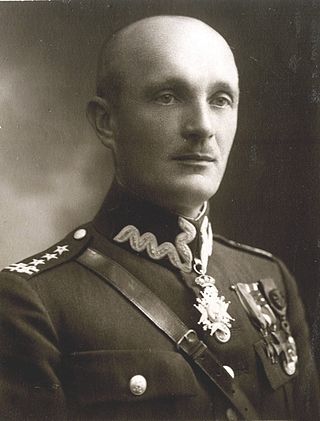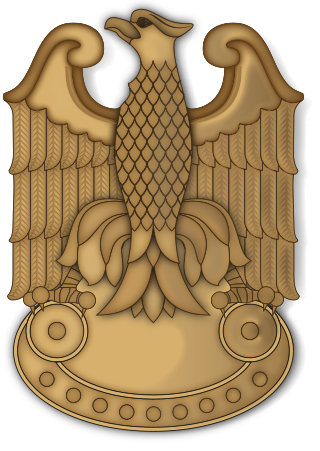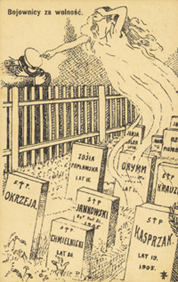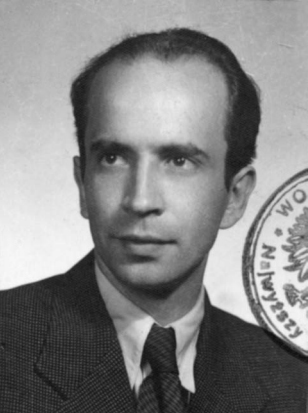History
On October 13, 1939, a few days after the end of the joint German and Soviet Invasion of Poland, a conspirational meeting of leaders of the National Party took place in Warsaw. During the meeting, a military organization called the National Army was created. Later on, it changed the name into Military Organization of the National Party (Organizacja Wojskowa Stronnictwa Narodowego), then it was called National Armed Units (Narodowe Oddzially Wojskowe), to finally be named Narodowa Organizacja Wojskowa (since July 1, 1941).
The NOW was politically, financially and personally overseen by Military Department of the National Party. At the same time, it had a widespread autonomy concerning its structure, intelligence, and training. Its first planned commandant was General Marian Januszajtis-Zegota, but he was arrested by the NKVD in Lwów, on October 27, 1939. Under the circumstances, the NOW was commanded by Colonel Aleksander Demidowicz-Demidecki. In December 1939, Demidecki left occupied Poland, and was replaced by Colonel Boleslaw Kozubowski.
In the late 1940 and 1941, the Gestapo carried out mass arrests of members of the National Party in Lesser Poland, Pomerelia and Warsaw. After this, the party had to re-create its depleted structures, and in September 1941, new leader of the SN, Stefan Sacha, named Colonel Jozef Rokicki new commandant of the NOW. In the spring 1942, several units of the NOW, mainly from Warsaw and Radom, decided to become part of the Home Army, and in May 1942, Stefan Sacha contacted General Stefan Rowecki, discussing with him merger of the two organizations. As a result, on August 23, 1942 an agreement was signed, and in November 1942, the merger was completed. Several NOW members, headed by August Michalowski, disagreed with it. The organization split into two parts - one was united with the Home Army, while another continued independent activities. The new NOW was headed by Colonel Ignacy Oziewicz, and was divided into five districts: Radom, Kielce, Częstochowa, Podlasie, Lublin and Łódź. In 1942, the new NOW merged with Military Organization Lizard Union, creating the National Armed Forces (Narodowe Sily Zbrojne, NSZ).
In 1942, before the split, the NOW had some 80,000 members, mostly in Greater Poland, Lesser Poland and Mazovia. It had its own guerilla units, under such leaders, as Franciszek Przysiezniak, Jozef Czuchra, Leon Janio and Jozef Zadzierski. The organization, however, concentrated its efforts on intelligence, and capturing German agents and collaborators. Weapons and ammunition were collected for the future uprising, a system of communication was created, underground press was distributed. There were several sabotage actions, and in order to rescue Jews, the NOW cooperated with other organizations. Some 1500 NOW soldiers fought in the Warsaw Uprising.

National Armed Forces was a Polish right-wing underground military organization of the National Democracy operating from 1942. During World War II, NSZ troops fought against Nazi Germany and communist partisans. There were also cases of fights with the Home Army.

Ignacy Oziewicz, pseudonyms: "Czesław", "Czesławski", "Netta", "Jenczewski" was a colonel of the Polish Army and a commandant of the National Armed Forces from 1942 to 1943.
National Democracy was a Polish political movement active from the second half of the 19th century under the foreign partitions of the country until the end of the Second Polish Republic. It ceased to exist after the German–Soviet invasion of Poland of 1939.

Gwardia Ludowa or GL was a communist underground armed organization created by the communist Polish Workers' Party in German-occupied Poland, with sponsorship from the Soviet Union. Formed in early 1942, within a short time Gwardia Ludowa became the largest clandestine fighting force on Polish soil which refused to join the structures of the Polish Underground State loyal to the London-based government-in-exile. In the January 1 of 1944 GL was incorporated into the communist Armia Ludowa.

The Union of Armed Struggle, also translated as the Union for Armed Struggle, Association of Armed Struggle, and Association for Armed Struggle, was an underground army formed in Poland following its invasion in September 1939 by Germany and the Soviet Union that opened World War II. It existed from 13 November 1939 until 14 February 1942, when it was renamed into Home Army.

General Wacław Jędrzejewicz was a Polish Army officer, diplomat, politician and historian, and subsequently an American college professor.

The Holy Cross Mountains Brigade was a controversial tactical unit of the Polish National Armed Forces established on 11 August 1944. It did not obey orders to merge with the Home Army in 1944 and was a part of the Military Organization Lizard Union faction, related to the National Radical Camp political party. Its soldiers fought simultaneously with the Nazi Germany, the Soviet Union and the Polish communist underground, though it sometimes collaborated with the Nazis to further its anti-communist, anti-Jewish and totalitarian goals.

In Poland, the resistance movement during World War II was led by the Home Army. The Polish resistance is notable among others for disrupting German supply lines to the Eastern Front, and providing intelligence reports to the British intelligence agencies. It was a part of the Polish Underground State.

The Polish Riflemen's Association known as Związek Strzelecki formed in great numbers prior to World War I. One of the better known associations called "Strzelec" was a Polish paramilitary cultural and educational organization created in 1910 in Lwów as a legal front of Związek Walki Czynnej, and somewhat reinstated in present-day Poland in 1991, after the fall of communism.

Aleksandra Piłsudska was a Polish socialist and independence activist, member of Polish Socialist Party and Polish Military Organisation, the second wife of Józef Piłsudski.

The Combat Organization of the Polish Socialist Party was an illegal Polish guerrilla organization founded in 1904 by Józef Piłsudski.

Maria Wittek served in the Polish Army and associated organizations from age 18 and, following retirement, in 1991 became the first Polish woman to be promoted to brigadier-general.
Irena Morzycka-Iłłakowicz was a Polish second Lieutenant of the National Armed Forces and intelligence agent. The daughter of Bolesław Morzycki and Władysława Zakrzewska and the sister of Jerzy, she was also a polyglot who spoke seven languages: Polish, French, English, Persian, Finnish, German and Russian.

Organizacja Wojskowa Związek Jaszczurczy was an organization of Polish resistance in World War II. Created in 1939 and transformed into National Armed Forces in 1942, it represented the far right of the Polish political spectrum (related to the National Radical Camp political party. It refused to recognise the broadly internationally recognised Polish Government-in-exile, although there was some uneasy tactical cooperation for practical reasons. It and descendants also refused to recognise the Soviet-aligned Polish Committee of National Liberation and continued to resist the new Polish communist regime and the USSR after the war.
The Józef Piłsudski Institute for Research in Modern History of Poland is an institution founded in Warsaw in 1923 to preserve and study the recent history of Poland.

The Pomeranian Griffin secret military organization was a Polish anti-Nazi resistance group active in Pomerania and East Prussia during World War II. A major Polish resistance organization in the Pomerania region, at its height in 1943 it might have had as many as 20,000 members, although only about 500 were active partisans in the forests (leśni).

Stanisław Bóbr-Tylingo (1919–2001) was a Polish-born historian who specialized in 19th-century Polish history, a Polish resistance fighter who after 1945 had to live his life in exile in Britain and Canada, and a decorated veteran of the Polish Warsaw Uprising in August–September 1944. For most of his adult life, he was a professor of history at Saint Mary's University in Halifax, Nova Scotia, Canada.

Second lieutenant Jerzy Zakulski was an attorney in interwar Poland, and World War II member of the National Armed Forces in German-occupied Poland. He was sentenced to death and executed by Stalinist officials in Soviet-controlled postwar Poland, on trumped-up charges of being an enemy spy.
Maciej Matthew Szymański was a member of the Polish Underground Army during World War II, an officer in the Polish paramilitary organization NSZ, participant in the Warsaw Uprising of 1944 at the age of 18, Canadian architect, draughtsman, and author of self-published memoirs and essays in his retirement.
Stanisław Ostwind-Zuzga was a master sergeant of the Polish Army, major of National Armed Forces (NSZ), local commandant of NSZ in Węgrów, and one of the highest-ranked officers of Jewish background in Polish anti-Nazi resistance during World War II.














